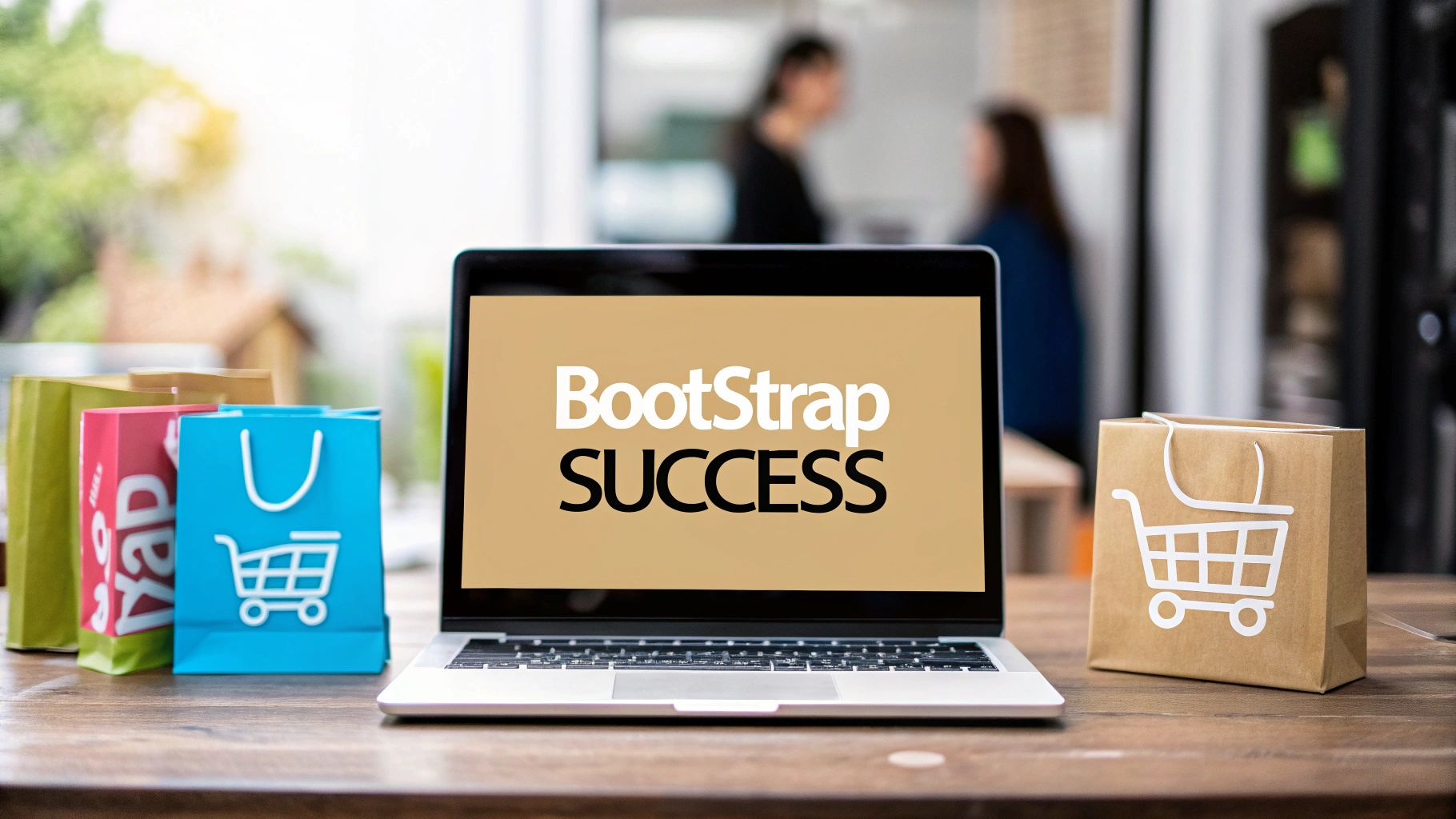Gumroad Review: Honest Insights on Pricing & Features
April 28, 2025

Inside Gumroad: How This Creator Platform Really Works

Gumroad has become a popular platform for creators selling digital products, physical goods, and services. It offers a simple way to set up an online storefront, manage products, and process payments. But how does this platform actually function behind the scenes? This review explores the inner workings of Gumroad.
Understanding Gumroad's Core Features
One of Gumroad's key strengths is its simplicity. Creators can easily upload products, set prices, and customize their product pages. The platform handles payment processing through various methods, including major credit cards and PayPal, ensuring smooth transactions for both buyers and sellers. Gumroad also provides basic audience management tools. These tools enable creators to connect with customers, fostering relationships and promoting future product launches. This is especially beneficial for encouraging repeat business.
Expanding Beyond Digital Products
Initially focused on digital product sales, Gumroad has broadened its offerings to meet the evolving needs of creators. This reflects the increasing complexity of the creator economy and the diversified income streams creators now pursue. Gumroad now supports calendar bookings, services, and tips. This allows creators to diversify their income beyond digital sales alone. This flexibility empowers creators to interact with their audience and monetize their skills in various ways. Learn more about how Gumroad has evolved: Gumroad's Evolution. For those interested in selling digital art specifically, check out this helpful resource: How to sell digital art.
User Experience: A Two-Sided Perspective
For sellers, Gumroad's intuitive interface simplifies listing products and managing sales. However, some creators feel the platform's customization options are limited. While basic branding is possible, advanced design control is restricted. For buyers, the purchasing process is typically seamless and user-friendly. Clear product descriptions and secure payment options create a positive buying experience. In essence, Gumroad serves as a great starting point for new creators. However, those seeking advanced customization may eventually outgrow the platform. For anyone exploring digital product sales, Gumroad offers an accessible entry point to the market.
The Real Cost of Selling: Gumroad's Pricing Decoded
Selling on Gumroad appears simple, but what are the actual costs? Understanding Gumroad's pricing is essential for any creator. This review examines the financial implications of using the platform.
Decoding the Flat 10% Fee
Gumroad uses a flat 10% fee based on your Gross Merchandise Value (GMV). This means for every $100 earned, Gumroad takes $10. This is simpler than platforms with complex tiered fees. However, this simplicity can become expensive as sales grow.
Comparing Past and Present Pricing
Gumroad previously used a variable transaction fee between 3.5% to 8.5%. The change to a flat 10% fee in early 2023 significantly impacted the company's finances. It more than doubled monthly revenue and made the company profitable. In 2023, Gumroad made $21 million, a 96% increase from $11 million in 2022. This jump was due to the pricing change, taking the company from a $1 million net loss in 2022 to a $9 million net profit in 2023. Discover more insights about Gumroad’s growth.
Let's explore the differences with a detailed comparison:
To understand the impact of this change, let's take a look at the table below:
Gumroad Fee Comparison: Before vs. After 2023
This table compares Gumroad's previous variable fee structure with the current flat fee model, showing how it affects creators at different sales volumes.
| Sales Volume | Old Fee Structure (3.5-8.5%) | Current Fee (Flat 10%) | Net Difference |
|---|---|---|---|
| $100 | $3.50 – $8.50 | $10.00 | +$1.50 – +$6.50 |
| $500 | $17.50 – $42.50 | $50.00 | +$7.50 – +$32.50 |
| $1,000 | $35.00 – $85.00 | $100.00 | +$15.00 – +$65.00 |
| $5,000 | $175.00 – $425.00 | $500.00 | +$75.00 – +$325.00 |
| $10,000 | $350.00 – $850.00 | $1,000.00 | +$150.00 – +$650.00 |
As you can see, the flat 10% fee structure can lead to a notable difference in fees, especially for higher sales volumes. While simpler, it’s important to factor this into your pricing strategy.

Hidden Costs to Consider
Besides the 10% fee, consider other expenses. Payment processing fees, usually 2.9% + $0.30 per transaction, are deducted before Gumroad's cut. Currency conversion fees also apply for international sales. These small percentages add up, especially for high-volume sellers or those with inexpensive products.
Strategic Pricing for Profitability
Successful Gumroad creators use strategic pricing to offset fees. This might involve raising prices slightly or offering product bundles to increase average order value. You might find this helpful: How to master digital product pricing strategies.
Product Suitability and Price Points
Consider how Gumroad's fees affect different products. High-value products like online courses absorb the 10% fee easier than low-priced downloads. For creators selling multiple low-cost items, the combined fees can significantly reduce profits. Consider your product mix and pricing to ensure Gumroad’s model aligns with your business goals.
Gumroad's Strengths and Weaknesses: The Unfiltered Truth

This Gumroad review wouldn't be complete without a frank discussion of its strengths and weaknesses. Understanding both is key for creators deciding if it's the right platform.
Gumroad's Advantages: Where It Excels
Gumroad shines in its simplicity. Setting up shop is remarkably quick, even for beginners. The interface is intuitive, letting creators list products, manage inventory, and track sales with ease. Plus, Gumroad's built-in discovery features help your products get seen by potential buyers on the platform. This organic reach is a big plus, especially for new creators building an audience.
- Simple setup: Get your shop running quickly.
- Intuitive interface: Manage products and sales efficiently.
- Built-in discovery: Reach new customers organically.
These features create a low barrier to entry for creators wanting to monetize their work.
Gumroad's Limitations: Areas for Improvement
However, no platform is perfect. One of Gumroad's limitations is customization. While basic branding is possible, options are limited compared to platforms like Shopify. This can make creating a truly unique brand experience a challenge. For instance, advanced design control over your storefront is restricted.
Gumroad's 10% fee is another factor to consider. While straightforward, this flat rate can impact your profits as sales grow. This can be a considerable expense for high-volume sellers or those with lower-priced products. Also, Gumroad's marketing tools, while functional, aren't as comprehensive as some competitors. This means creators might need to put in more manual effort for off-platform promotion.
- Limited customization: Restricts branding and design options.
- 10% fee: Can affect profits, especially with high sales.
- Basic marketing tools: Requires more manual promotion.
To help illustrate these points, let's take a look at the following comparison table:
Gumroad at a Glance: Strengths vs. Limitations
A comprehensive evaluation of Gumroad's key advantages and disadvantages for different creator types
| Feature/Aspect | Strengths | Limitations | Best For |
|---|---|---|---|
| Ease of Use | Simple setup, intuitive interface | Limited customization options | Beginners, creators seeking simplicity |
| Discovery | Built-in discovery features, organic reach | Limited marketing tools | New creators, building an audience |
| Pricing | Straightforward 10% fee | Can impact profits with high sales volume | Creators with lower sales volume, higher-priced products |
| Customization | Basic branding options | Restricted design flexibility, limited storefront control | Creators comfortable with simpler setups |
| Marketing | Basic built-in tools | Less comprehensive than competitors, requires manual effort | Creators with simple marketing strategies, or those using external marketing tools |
This table summarizes the key strengths and limitations of Gumroad, highlighting how these factors can influence suitability for various creator types. The ease of use is a significant advantage for beginners, while the limited customization and marketing tools might be less ideal for established creators with complex needs. The 10% fee structure requires careful consideration in relation to sales volume and product pricing.
Gumroad for Different Creators: Finding Your Fit
How do these pros and cons affect different creators? For digital artists and writers selling single products, Gumroad's simplicity is a major benefit. But course creators might find the limited customization options challenging. Similarly, creators with complex marketing strategies may prefer platforms with more robust features. Read also: How to master increasing sales on other platforms.
Ultimately, evaluating Gumroad comes down to your specific needs and business model. Do its strengths outweigh its limitations for your creative work and business goals? This review aims to give you the information you need to decide.
Where Gumroad Stands in Today's Creator Economy

The creator economy is a vibrant and ever-evolving space. New platforms and innovative business models pop up regularly. This makes understanding Gumroad's place in this landscape essential for creators considering the platform. This review explores Gumroad’s relevance, market presence, and overall influence.
Gumroad's Market Presence and Creator Demographics
Gumroad has carved out a niche, primarily serving creators of digital products, online courses, and similar content. It's a popular choice for independent artists, writers, and educators who prefer a direct-to-consumer sales approach.
However, compared to giants like Etsy for physical goods or Patreon for memberships, Gumroad's market share is smaller. This focused approach has its pros and cons. While it caters well to specific creators, it might also limit broader reach.
For example, Gumroad is a great fit for creators who value simplicity and direct control. The platform's streamlined setup and payment processing make it easy to start selling quickly. Gumroad also offers features to help creators connect with new customers directly on the platform.
Adapting to the Digital Product Boom
The recent surge in digital product consumption, accelerated by the pandemic, has fueled the growth of platforms like Gumroad. This increased demand allowed Gumroad to expand its offerings, including adding support for physical products and services.
But these adaptations also came with a pricing change. The shift to a flat 10% fee on all sales has sparked discussions among creators about its impact on profitability. This highlights the challenge of balancing platform growth with creator needs in a competitive market. Learn more in our article comparing different ecommerce platforms.
Gumroad's Influence on Pricing and Customer Expectations
Gumroad’s streamlined approach has left a mark on the wider creator economy. Its emphasis on direct sales, transparent pricing, and creator control has shaped what customers expect from digital products.
Other platforms are adopting similar models, showcasing Gumroad’s influence beyond its own user base. As of 2021, Gumroad was valued at $100 million. This followed several funding rounds, including a crowdfunding campaign that raised $5 million from over 7,000 investors. In total, Gumroad has received approximately $16.46 million in funding. For more on this topic, see Gumroad's Valuation and Funding.
This demonstrates how Gumroad has set a precedent for how digital products are sold and consumed. This impact highlights its ongoing role in shaping the future of the creator economy.
Beyond Gumroad: Alternatives That Might Serve You Better
Is Gumroad the best platform for your creative endeavors? This Gumroad review wouldn't be complete without exploring other options. Let's compare Gumroad with popular alternatives like Patreon, Teachable, Podia, SendOwl, and direct website sales using Shopify or WooCommerce.
Patreon: For Membership-Driven Communities
Patreon shines when it comes to building membership-driven communities. It lets creators offer exclusive content and perks to subscribers for recurring monthly payments. This model works well for ongoing content like podcasts, videos, or writing. However, Patreon isn't built for one-time product sales. While selling products is possible, it's not the platform's strength. For example, a musician could share behind-the-scenes content and early access to new music on Patreon, while selling albums on Gumroad or another platform.
Teachable and Podia: Homes for Online Courses
Teachable and Podia are specifically designed for online course creators. They offer robust features for hosting, managing, and delivering courses, including student progress tracking, quizzes, and community forums. While Gumroad can host courses, it lacks these specialized tools. If your main focus is online education, Teachable or Podia might be a better choice.
SendOwl: Streamlined Digital Product Delivery
SendOwl focuses on secure and automated digital delivery. It's a good option for selling ebooks, software, and other downloadable files. While Gumroad offers similar features, SendOwl's specialized approach can make things smoother for certain product types. A software developer might prefer SendOwl for its licensing and update features, for example.
Shopify and WooCommerce: Powering Your Own Storefront
For complete control over your brand and sales, consider a website with Shopify or WooCommerce. These platforms offer lots of customization and flexibility, but also require more setup and management. This means more control comes with more responsibility for marketing, payments, and customer support. You might be interested in this article: How to master creating shoppable bio links.
Comparing Key Factors: Fees, Features, and Fit
Picking the right platform means carefully weighing several factors:
- Transaction Fees: Each platform has its own fee structure. Research the costs, including payment processing and other fees.
- Features: Think about the tools you need, like membership management, course hosting, or marketing automation.
- Audience Reach: Some platforms have larger built-in audiences. Consider where your target audience spends time online.
- Customization: How much control do you want over your branding and storefront design?
Platform Migration: Challenges and Strategies
Moving platforms can be tricky, especially when migrating your audience and content. Plan your transition carefully and communicate clearly with your customers. For example, you could offer incentives for customers to join you on the new platform.
The best platform ultimately depends on your specific needs and business model. This Gumroad review aims to give you the information you need to make a smart choice.
The Decision Guide: Is Gumroad Your Perfect Match?
Deciding if Gumroad is right for you requires careful thought. It's not a universal solution. Your success hinges on several things, from the kind of creator you are to the type of product you offer. This Gumroad review will help you figure that out.
Creator Type and Business Stage: Finding Your Fit
Different creators find different levels of success on Gumroad. Digital artists and writers selling individual items often appreciate Gumroad's simple setup. Course creators, however, might need more features, such as those offered by platforms like Teachable or Podia. For example, someone selling ebooks or design templates might love Gumroad's simplicity. Someone offering a full online course might need more specialized learning management system (LMS) tools.
Your business stage matters too. Gumroad's user-friendliness makes it great for creators just starting out. But as your business grows, the 10% fee can impact your earnings. This might make other platforms more attractive for high-volume sellers. Gumroad is a fantastic starting point, but bigger creators with lots of sales might need to rethink its long-term value.
Product Characteristics: A Critical Assessment
Your product type significantly influences platform fit. Price point is key. High-value products, like online courses or software, absorb the 10% fee more easily than low-priced items, like ebooks or templates. This is because the profit margin on higher-priced products stays high even after the fee.
Product complexity is another important factor. For simple downloads, Gumroad's delivery works well. But for complex products needing lots of customer support or software updates, a more focused platform might be better. Selling a simple PDF guide is easy on Gumroad. Selling software with constant updates might need a different platform. Selling physical products? Shopify or Etsy might be better suited for that.
Practical Questions and Red Flags
To see if Gumroad is right for you, think about these questions:
- What kind of creator are you?
- What stage is your business at?
- What's the average price of your products?
- How complex are your products to deliver and support?
Here are some red flags that Gumroad might not be the best fit:
- High sales volume with low-priced products: The 10% fee can really cut into profits.
- Need for extensive product customization or branding: Gumroad's customization is limited.
- Complex product delivery or ongoing customer support: Gumroad might not have all the features you need.
The Hybrid Approach: Leveraging Multiple Platforms
Sometimes, using Gumroad with other platforms works best. You could use Gumroad for single products and Patreon for a membership community. Or, you might use Shopify for physical goods and Gumroad for digital downloads. This lets you use the best parts of each platform.
Ready to make a great link-in-bio page for your Shopify store? Check out LinkShop. Explore LinkShop now!



